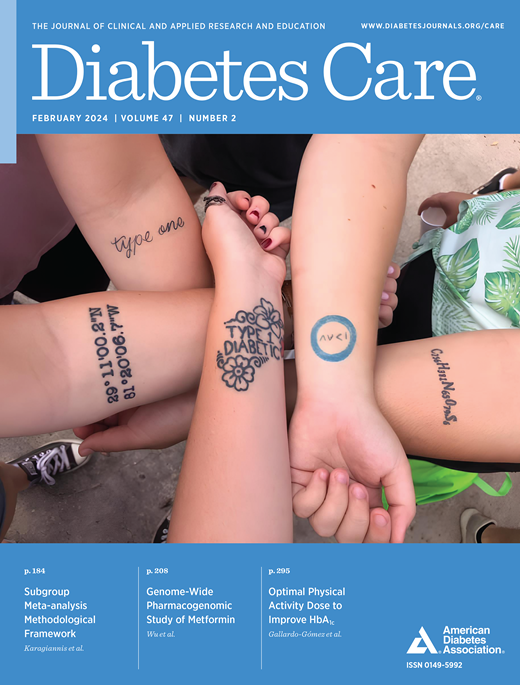2型糖尿病患者主要冠状动脉或脑血管事件后病死率的国际差异:来自ADVANCE、TECOS和EXSCEL的证据
IF 16.6
1区 医学
Q1 ENDOCRINOLOGY & METABOLISM
引用次数: 0
摘要
目的探讨不同地理区域和国家收入水平的2型糖尿病患者发生重大冠状动脉或脑血管事件后病死率的差异。研究设计和方法:我们研究了ADVANCE、TECOS和excel参与者在试验期间经历过主要冠状动脉(致死性或非致死性心肌梗死或心源性猝死)或脑血管(致死性或非致死性中风)事件。病死率定义为事件发生时或事件发生后30天内死亡。我们将地理区域与参考类别(西欧、北美或澳大利亚和新西兰)进行了比较,并根据世界银行的人均国民总收入将中低收入国家与参考类别(高)进行了比较。采用logistic回归对每个试验的个体参与者数据进行非调整和调整分析,并对结果进行荟萃分析。对既往心血管事件和危险因素进行了调整。结果40,563名研究参与者中有2,574例主要冠状动脉事件和1,247例脑血管事件。与参照组相比,亚洲、中欧和东欧、南美和非洲的冠状动脉病死率校正优势比(95% ci)分别为3.31(2.32-4.72)、2.78(2.11-3.66)和2.84(1.71-4.73)。中低收入国家与高收入国家的比值比为3.07(2.41-3.92)。重大脑血管事件后的病死率没有因地理区域或收入群体而异。结论:与西方国家相比,亚洲、中欧和东欧、南美和非洲的冠状动脉术后病死率明显较高,中低收入国家的冠状动脉术后病死率高于高收入国家。本文章由计算机程序翻译,如有差异,请以英文原文为准。
International Variation in Case Fatality After Major Coronary or Cerebrovascular Events in Individuals With Type 2 Diabetes: Evidence From ADVANCE, TECOS, and EXSCEL
OBJECTIVE To examine differences in case-fatality incidence among individuals with type 2 diabetes after major coronary or cerebrovascular events by geographic region and country income level. RESEARCH DESIGN AND METHODS We studied ADVANCE, TECOS, and EXSCEL participants who experienced within-trial major coronary (fatal or nonfatal myocardial infarction or sudden cardiac death) or cerebrovascular (fatal or nonfatal stroke) events. Case fatality was defined as death at the time or within 30 days of an event. We compared geographic regions with the reference category (Western Europe, North America, or Australia and New Zealand) and compared medium- and low-income countries, based on gross national income per capita by the World Bank, with the reference category (high). Unadjusted and adjusted analyses were performed for each trial using logistic regression for individual participant data, and the results were meta-analyzed. Adjustments were made for previous cardiovascular events and risk factors. RESULTS There were 2,574 major coronary and 1,247 cerebrovascular events among the 40,563 study participants. Postcoronary case-fatality adjusted odds ratios (95% CIs), compared with the reference group, were 3.31 (2.32–4.72), 2.78 (2.11–3.66), and 2.84 (1.71–4.73) for Asia, Central and Eastern Europe, and South America and Africa, respectively. The odds ratio for low- and middle-income versus high-income countries was 3.07 (2.41–3.92). Case fatality after a major cerebrovascular event did not differ by geographic region or income group. CONCLUSIONS Postcoronary case fatality was substantially higher in Asia, Central and Eastern Europe, and South America and Africa compared with Western countries and higher in low- and middle-income countries compared with high-income countries.
求助全文
通过发布文献求助,成功后即可免费获取论文全文。
去求助
来源期刊

Diabetes Care
医学-内分泌学与代谢
CiteScore
27.80
自引率
4.90%
发文量
449
审稿时长
1 months
期刊介绍:
The journal's overarching mission can be captured by the simple word "Care," reflecting its commitment to enhancing patient well-being. Diabetes Care aims to support better patient care by addressing the comprehensive needs of healthcare professionals dedicated to managing diabetes.
Diabetes Care serves as a valuable resource for healthcare practitioners, aiming to advance knowledge, foster research, and improve diabetes management. The journal publishes original research across various categories, including Clinical Care, Education, Nutrition, Psychosocial Research, Epidemiology, Health Services Research, Emerging Treatments and Technologies, Pathophysiology, Complications, and Cardiovascular and Metabolic Risk. Additionally, Diabetes Care features ADA statements, consensus reports, review articles, letters to the editor, and health/medical news, appealing to a diverse audience of physicians, researchers, psychologists, educators, and other healthcare professionals.
 求助内容:
求助内容: 应助结果提醒方式:
应助结果提醒方式:


